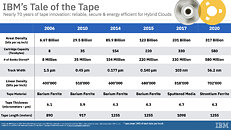- Joined
- Aug 19, 2017
- Messages
- 3,201 (1.11/day)
Magnetic tape storage is one of the oldest technologies used for storing data. The technology was invented way back in 1928, and it is almost 100 years old. By today's standards, the technology is considered to be slow, however, it offers something that no modern HDD or SDD offers. Today, in collaboration with Fujifilm, IBM has developed a Strontium Ferrite (SrFe) magnetic layer for LTO-8 tapes that are capable of storing an amazing 580 TeraBytes of data in a single cartridge. The new technology will enable the modern world to store ever-increasing data sizes we are now counting in zettabytes. To store all of that data, one would need a high-capacity storage device to store all of the "cold data" that doesn't need real-time processing and has information of value.
That is exactly why IBM and Fujifilm have been developing the LTO-8 tape drives that are capable of 580 TB of capacity in a single cartridge. The technology can achieve that capacity thanks to the Strontium Ferrite (SrFe), which is capable of 317Gb/in2 recording density. With 1255 meters of the tape, IBM and Fujifilm have been able to achieve this density metric.


View at TechPowerUp Main Site
That is exactly why IBM and Fujifilm have been developing the LTO-8 tape drives that are capable of 580 TB of capacity in a single cartridge. The technology can achieve that capacity thanks to the Strontium Ferrite (SrFe), which is capable of 317Gb/in2 recording density. With 1255 meters of the tape, IBM and Fujifilm have been able to achieve this density metric.


View at TechPowerUp Main Site







